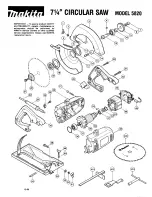
7
GB/IE/NI
15. Make sure that fixed reducer rings are parallel to each other.
16. Handle insertion tool with caution. They are ideally
stored in the originally package or special containers.
Wear protective gloves in order to improve grip and to
further reduce the risk of injury.
17. Prior to the use of insertion tools, make sure that all pro-
tective devices are properly fastened.
18. Prior to use, make sure that the insertion tool meets the
technical requirements of this electric tool and is properly
fastened.
19. Only use the supplied saw blade for cutting wood, never
for the processing of metals.
20. Only use saw blade diameters in accordance with the
markings on the saw.
21. Use additional workpiece supports, if required for work-
piece stability.
22. Workpiece support extensions must always be secured
and used during work.
23. Replace table inserts when worn!
24. Avoid overheating of the saw teeth.
25. When sawing plastic, avoid melting of the plastic. Use
the appropriate saw blades for this purpose. Replace
damaged or worn saw blades immediately. When the
saw blade overheats, stop the machine. Allow the saw
blade to cool down before using the power tool again.
Attention: Laser radiation
Do not stare into the beam
Class 2 laser
Protect yourself and you environment from acci-
dents using suitable precautionary measures!
• Do not look directly into the laser beam with unprotected
eyes.
• Never look into the path of the beam.
• Never point the laser beam towards reflecting surfaces and
persons or animals. Even a laser beam with a low output can
cause damage to the eyes.
• Caution - methods other than those specified here can result
in dangerous radiation exposure.
• Never open the laser module. Unexpected exposure to the
beam can occur.
• If you do not use the device for a long time, the batteries
should be removed.
• The laser may not be replaced with a different type of laser.
• Repairs of the laser may only be carried out by the laser
manufacturer or an authorised representative.
Safety instructions for handling batteries
1. Always make sure that the batteries are inserted with the
correct polarity (+ and –), as indicated on the battery.
2. Do not short-circuit batteries.
3. Do not charge non-rechargeable batteries.
4. Do not overcharge batteries!
5. Do not mix old and new batteries or batteries of different
types or manufacturers! Replace an entire set of batteries
at the same time.
6. Immediately remove used batteries from the device and
dispose of them properly! Do not dispose batteries with
household waste. Defective or used batteries must be re-
cycled according to Directive 2006/66 / EC. Give back
batteries and / or the device has been offered to the col-
lective facilities. About disposal facilities you can inform
by your municipal or city government.
7. Do not allow batteries to heat up!
8. Do not weld or solder directly on batteries!
9. Do not dismantle batteries!
10. Do not allow batteries to deform!
11. Do not throw batteries into fire!
12. Keep batteries out of the reach of children.
13. Do not allow children to replace batteries without super-
vision!
14. Do not keep batteries near fire, ovens or other sources of
heat. Do not use batteries in direct sunlight or store them
in vehicles in hot weather.
15. Keep unused batteries in the original packaging and
keep them away from metal objects. Do not mix un-
packed batteries or toss them together! This can lead to
a short-circuit of the battery and thus damage, burns or
even the risk of fire.
16. Remove batteries from the equipment when it will not be used
for an extended period of time, unless it is for emergencies!
17. NEVER handle batteries that have leaked without appro-
priate protection. If the leaked fluid comes into contact with
your skin, the skin in this area should be rinsed off under
running water immediately. Always prevent the fluid from
coming into contact with the eyes and mouth. In the event
of contact, please seek immediate medical attention.
18. Clean the battery contacts and corresponding contacts in
the device prior to inserting the batteries.
Residual risks
The machine has been built according to the state
of the art and the recognised technical safety re-
quirements. However, individual residual risks can
arise during operation.
• Health hazard due to electrical power, with the use of im-
proper electrical connection cables.
• Furthermore, despite all precautions having been met, some
non-obvious residual risks may still remain.
• Residual risks can be minimised if the “Safety information“
and the “Proper use” are observed along with the whole of
the operating instructions.
• Do not load the machine unnecessarily: excessive pressure
when sawing will quickly damage the saw blade, which re-
sults in reduced output of the machine in the processing and
in cut precision.
• When cutting plastic material, please always use clamps:
the parts which should be cut must always be fixed between
the clamps.
• Avoid accidental starting of the machine: the operating but-
ton may not be pressed when inserting the plug in an outlet.
• Use the tool that is recommended in this manual. In doing so,
your machine provides optimal performance.
• Hands may never enter the processing zone when the ma-
chine is in operation.
• Release the handle button and switch off the machine prior
to any operations.
Содержание PKS 1500 B3
Страница 4: ...8 27 28 7 8 11 33 34 12 36 35 36 6 8a 8b 22 B 22 22a 10 29 30 5 6 9 32 25 4 13 37 31 ...
Страница 5: ...15 14 E E E E ...
Страница 98: ......
Страница 99: ......













































